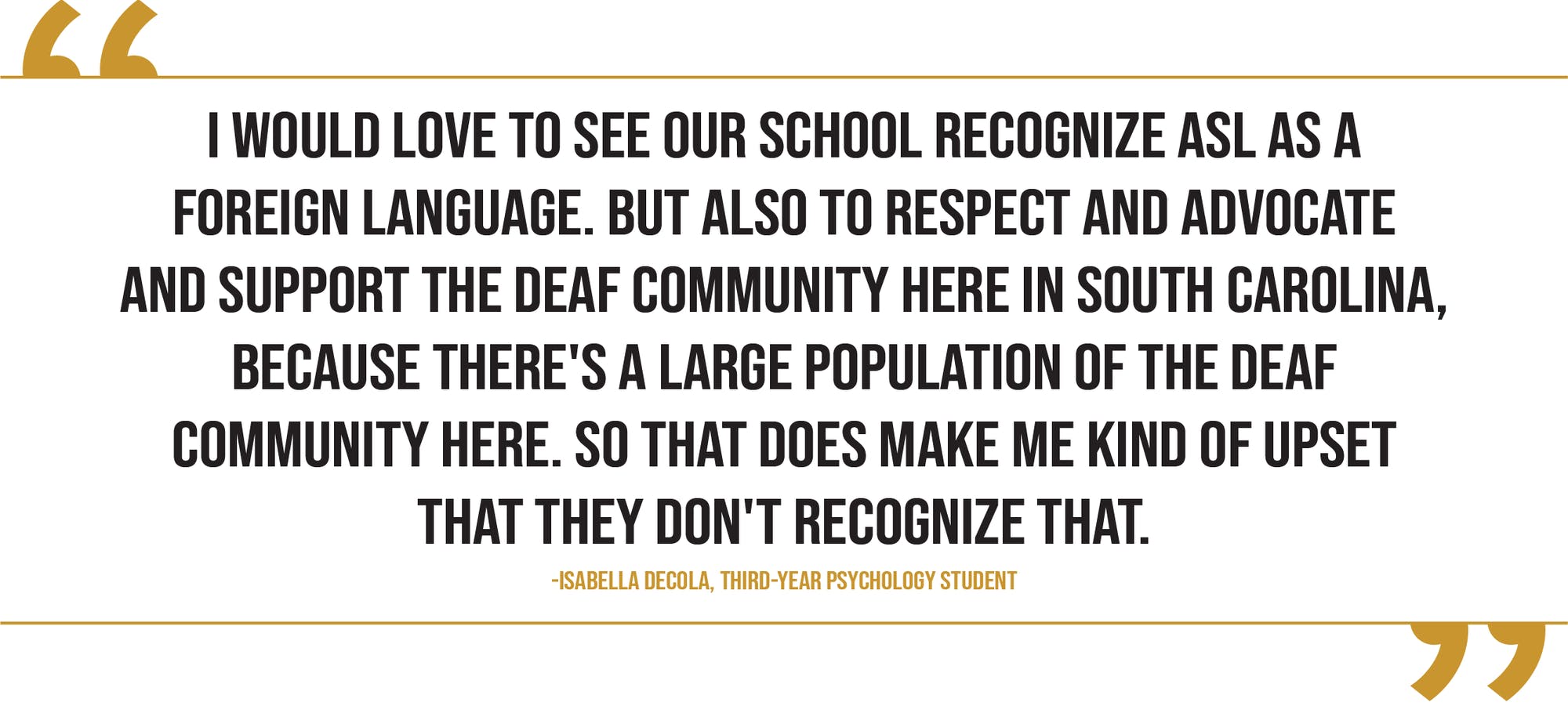American Sign Language classes will qualify for the Carolina Core foreign language requirement starting in fall 2024 after the language's introduction on a trial basis in 2019.
The faculty senate's approval was the final step in a lengthy process of voting and evaluation both inside and outside of USC's Department of Languages, Literatures and Cultures in order for the classes to be eligible for Carolina Core credit. Prior to completing this process, students could only choose from spoken languages to fulfill the requirement.
The process also required significant student interest from the beginning. The language was added to the Less Commonly Taught Languages division of USC's Department of Languages, Literatures & Cultures in 2019, and fourth-year public health student Kristen Carney created a Change.org petition in February 2022 asking for American Sign Language classes to count for a Carolina Core credit. Carney's petition has since gathered more than 1,400 signatures.
The department’s chair, Paul Malovrh, said the Department of Languages, Literatures & Cultures was aware of demand from students, but the addition needed multiple years to get each necessary approval.
“We've been spending a good two or three years trying to get this to happen, and it looks very positive,” Malovrh said.
The faculty senate said in a report from December 2022 that Intermediate American Sign Language I and Intermediate American Sign Language II could be added as new courses intended for completed proficiency in Basic Proficiency in American Sign Language, which expanded opportunities to learn the language at USC.
Finding professors and expanding awareness and support for the new options takes more time, Malovrh said.
"It could take two or three years to get something like that through the system. We have to make sure that we have the infrastructure to offer it and things like that in terms of staffing. And we have to make sure that there's a demand for it,” Malovrh said.
Malovrh said there are several factors to consider before expanding any foreign language program for more students, aside from just now getting the faculty senate's approval.
"Currently, we are in the process of requesting a hiring line to hire a professor that could teach four courses a semester," Malovrh said. "That’s determined by enrollment numbers, really. So if we offer two sections, for example, it's because those are the sections that we were able to fill."
Students interested in taking sign language courses have so far been limited to only two classes per semester, and each had just 22 available seats. Andrea Martinez-Johnson, USC’s only American Sign Language instructor, said she has seen several strides in students embracing the language since she began working at USC in 2004.
One of the current struggles Martinez-Johnson said she faces in teaching American Sign Language is that a limited number of students are able to access her courses before their senior year. Typically, Martinez-Johnson finds her two courses full or near-full while registration is still ongoing and availability has been limited to upperclassmen.
“I'm not sure why. I mean, they're saying that you have to be a senior in order to be in those classes, so that means you only have one year to learn. And that really, honestly, does not make sense to me. They should allow freshmen, sophomores and juniors — they should be allowed to pick those ASL classes. And again, that's been an issue since 2004,” Martinez-Johnson said.
Third-year psychology student Isabella DeCola said the slow approval process has not stopped her from pursuing the language, however. DeCola said she has sought out other opportunities to learn and practice signing, such as volunteering at Camp Wonder Hands, a camp hosted by Prisma Health Children's Hospital for children who are deaf and hard of hearing.
DeCola was also one of the signatures on the petition and was able to get into the two sign language courses offered at USC during her freshman year.
“I would love to see our school recognize ASL as a foreign language,” DeCola said. “But also to respect and advocate and support the deaf community here in South Carolina, because there's a large population of the deaf community here. So that does make me kind of upset that they don't recognize that.”

DeCola said she has stayed interested in American Sign Language but ultimately chose to fulfill her foreign language requirement in Spanish by studying abroad in Spain. However, she said she sought out more knowledge and experience in non-verbal communication at Gallaudet University's summer residency program and maintained connections with her deaf friends.
The addition of American Sign Language classed for foreign language credits allows USC the potential to catch up to programs at other schools across the United States. Clemson University is well-known for its own sign language programs, according to Martinez-Johnson and Malovrh, as the university offers an American Sign Language minor and 34 courses within the program as opposed to the two courses currently available for USC students.
"Last spring, we had a professor from Clemson come and speak at the University of South Carolina about their program, and that was supported by the college, which I think is sort of indicative of the college's desire to also have American Sign Language grow on our campus," Malovrh said.
Building up an offering similar to the American Sign Language programs offered at other universities could help hearing students work alongside deaf and hard-of-hearing individuals regardless of where they work in the United States, Martinez-Johnson said.
"There are a lot of programs at other universities that have concentrations in sign language and majors and minors in American Sign Language or in interpreting," DeCola said. "Just having an academic support system for that would probably advance the support and awareness of deaf culture in general."

